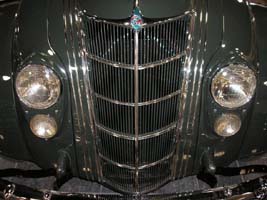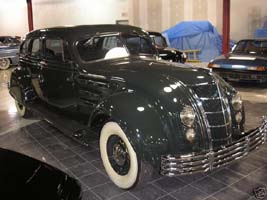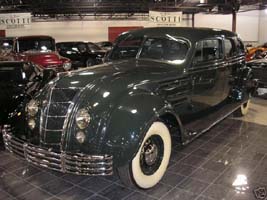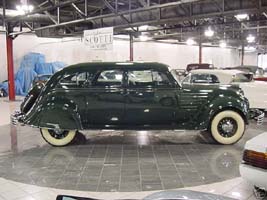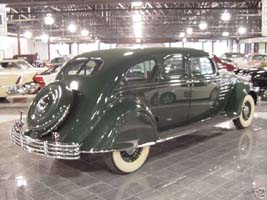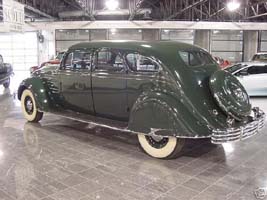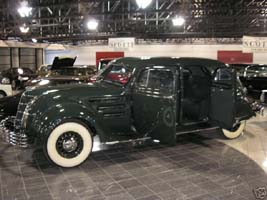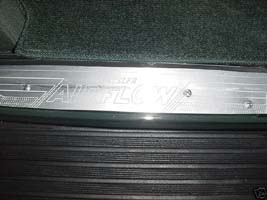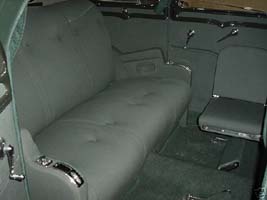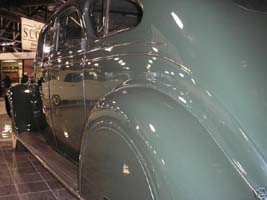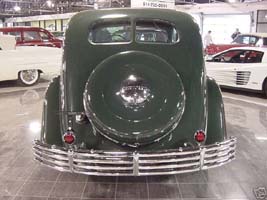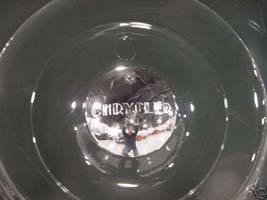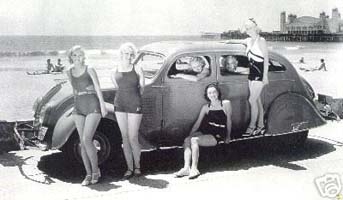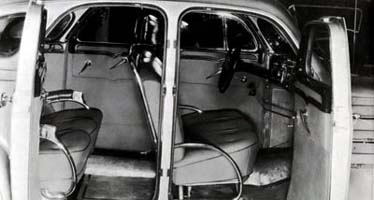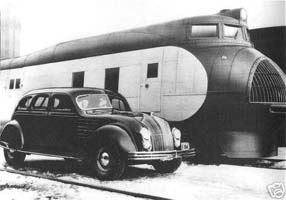1934 Chrysler CX Airflow 8-passenger Limousine...Fully Equipped, Leather Interior, Wheel Covers, Rear-Folding Seats...we are proud to present an exceptionally rare vehicle...perhaps one of only two made and the only known surviving example in the world...!...A genuine Art Deco masterpiece of Automotive Sculpture as well as a unique piece of Chrysler history! How do you valuate a one-of-a-kind work of art when it simply isn't possible to find another like this anywhere? Priceless! Yet it is now available for your bidding pleasure and purchase for the pride of ownership ecstasy in the rarified atmosphere of a collector car cognoscenti's pantheon
Custom Imperial Airflow--Series CX--Eight: This was a new intermediate-sized series in the Airflow line.It was actually a long wheelbase version of the Imperial Airflow CV and used the same styling and equipment features...Even the engine had the same specifications...Although four body styles were cataloged, it appears that possibly only two town limousines and one prototype version of the town sedan were built! Special features included rear divider, jump seats, dual "step plate"running boards with chrome trim moldings and "optional" four bar bumpers...They had rounded radiator grilles and headlamps and parking lights that were integral with the hood.
Originally, the Airflow was to have appeared only with the DeSoto badge, but that changed when the boss decided there ought to be a Chrysler version to celebrate the 10th anniversary of his namesake marque.
The all-straight-eight Chrysler Airflow lineup initially consisted of three model groups. At the bottom was the 123-inch-wheelbase Series CU, with the DeSoto's four body
types and a 298.7-cid engine packing 112 horsepower.
Next up was the Series CV Airflow Imperial Eight on a 128-inch wheelbase and without the brougham model. Its 323.5-cid powerplant produced 130 horsepower and, like all Chrysler engines that year, boasted an aluminum cylinder head.
Pride of the fleet was the Series CW Airflow Custom Imperial, spanning a huge 146.5-inch wheelbase and powered by the company's largest eight, a 384.8-cid nine-main-bearing unit rated at 145 horsepower. Body styles comprised eight-passenger four-door sedan and town sedan in standard and limousine form, the latter with division window and different trim for the separate chauffeur's compartment.
All CW bodies were supplied by the famed LeBaron coachworks. Chrysler prices ranged from $1,245 for any Series CU up to $5,145 for the impressive Custom Imperial town limousine. The DeSotos were priced at $995 across the board.
In construction, the Airflows were completely different from other cars of their day, a fact that may be difficult to appreciate in ours. While the 1934 Plymouth had a newly designed independent front suspension, the Airflows were a throwback in having a tubular front axle, the same type as on the very first Chryslers.
Nevertheless, the DeSoto brochure boasted that you could read a newspaper at 80 mph over almost any road. Rear seat passengers sat 20 inches ahead of the rear axle instead of directly over it, because the engine, the heaviest single component in any car, was moved a corresponding distance ahead to rest over the front axle.
This left riders almost at the car's exact center of dynamic balance, aided by slightly front-heavy weight distribution (55/45 percent front/rear) compared to that of conventional cars, where the rear axle usually carried most of the load. Also enhancing ride comfort were extra-long leaf springs with more leaves all around. On the Chrysler CU, for example, the front springs measured 44.125 inches and the rears 52.5 inches, with no fewer than 10 leaves at the front and eight in the back...
Distinctive Features of the 1934 Chrysler/DeSoto Airflow
The result of all the 1934 Chrysler/DeSoto Airflow's engineering innovation was what Chrysler called "Floating Ride," and the cars included a number of distinctive features.
Blared the DeSoto brochure: "No matter whether you are sitting in the front seat or the back, you can relax completely and utterly . . . you ride comfortably 'amidships' . . . experience no bumping, bouncing, or vibration of any kind. The bumps just seem to flow under the car without reaching you. It is impossible to realize how great a relief this is until you actually try it."
Also missing in the Airflow was the typical composite body common to virtually all other cars of the period. In its place was one complete steel unit "built like a modern bridge."
Box girders ran longitudinally up from the front, into the roof rails and down to the tail, and were joined with vertical and horizontal members to create an exceptionally strong structure that Chrysler claimed was "40 times more rigid than a conventional frame and body . . . The entire car moves as whole instead of the frame vibrating against the body," although this was not, in fact, true unit construction.
Flush headlamps were a 1934 feature.
The "girder-trussed" arrangement was not engineer Carl Breer's alone but also reflected input from the Budd Company and Chrysler's chief body engineer, Oliver Clark. Incidentally, Budd ended up supplying most Airflow sheetmetal aft of the cowl, while the entire front end was built up as a subassembly at the Dodge plant in Hamtramck.
Besides its solid front axle, the Airflow was curiously old-fashioned in retaining the traditional fabric roof insert, although this was replaced for 1936 by a solid steel panel, a response to GM's introduction of the "Turret Top."
Inside, the Chrysler/DeSoto Airflow could comfortably accommodate three in front on a seat 50 inches wide, 10 inches broader than those of ordinary cars. The seat itself was mounted high off the floor on a novel chrome-plated tubular frame (also used for the rear bench), which allowed air to circulate beneath and flow back to the aft compartment for more efficient heating and true windows-up ventilation.
Center-latch doors revealed a vast interior with chair-height seats on chrome-tube frames.
Other interesting touches included commodious twin gloveboxes, one at each end of the dash, and full instrumentation housed in two circular dials flanking a steering column angled much more horizontally than the then-current norm. The glass area was uncommonly generous all around, "a vital new safety feature" that made for improved over-the-road vision.


